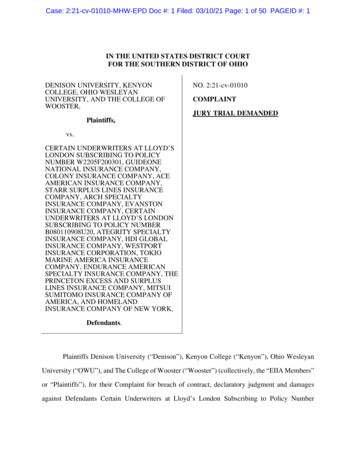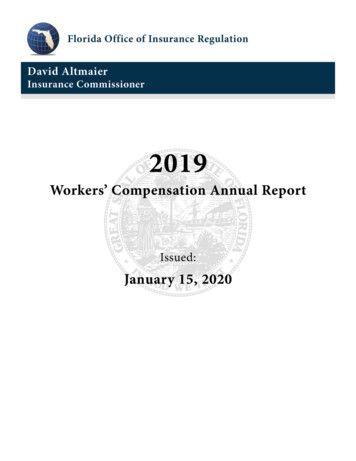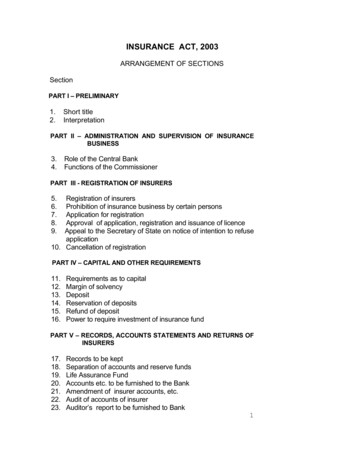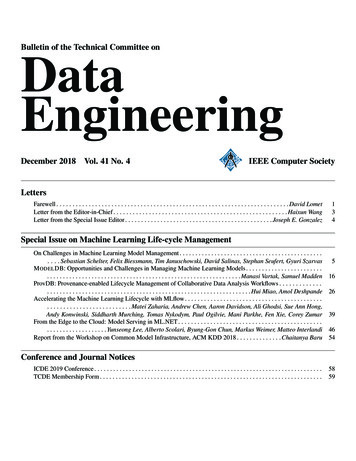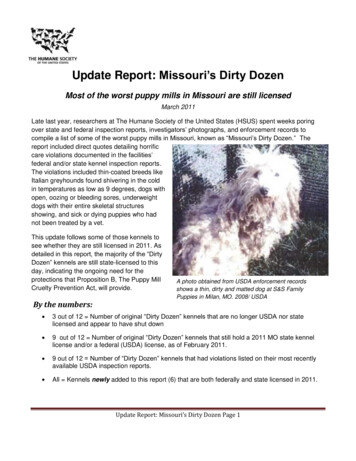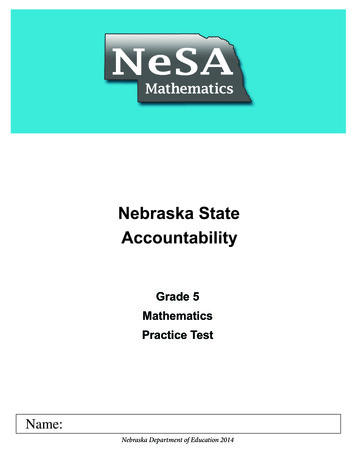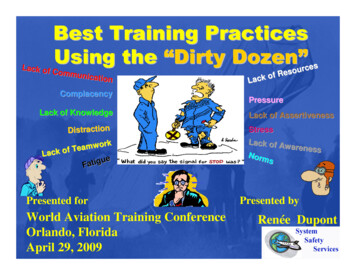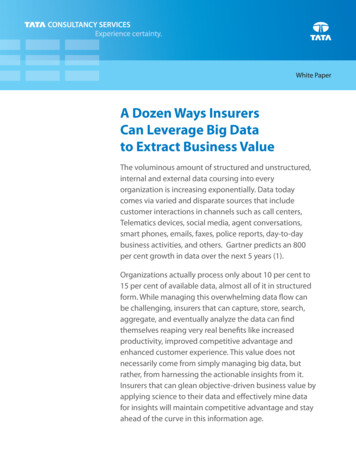
Transcription
A Dozen Ways InsurersCan Leverage Big Datato Extract Business ValueThe voluminous amount of structured and unstructured,internal and external data coursing into everyorganization is increasing exponentially. Data todaycomes via varied and disparate sources that includecustomer interactions in channels such as call centers,Telematics devices, social media, agent conversations,smart phones, emails, faxes, police reports, day-to-daybusiness activities, and others. Gartner predicts an 800per cent growth in data over the next 5 years (1).Organizations actually process only about 10 per cent to15 per cent of available data, almost all of it in structuredform. While managing this overwhelming data flow canbe challenging, insurers that can capture, store, search,aggregate, and eventually analyze the data can findthemselves reaping very real benefits like increasedproductivity, improved competitive advantage andenhanced customer experience. This value does notnecessarily come from simply managing big data, butrather, from harnessing the actionable insights from it.Insurers that can glean objective-driven business value byapplying science to their data and effectively mine datafor insights will maintain competitive advantage and stayahead of the curve in this information age.
About the AuthorsAjay Bhargava, Director, Analytics & Big Data, TCSAjay Bhargava has more than 23 years of Industry, Research, and Teaching experience in the areasrelating to Databases, Enterprise Data Management, Data Warehousing, Business Intelligence, andAdvanced Analytics. Over the years, he has provided business and technology oriented strategicthinking, mentoring, and customer-centric solutions to his clients.Ajay heads up the Analytics & Big Data Center of Excellence for TCS for Insurance & Healthcarecustomers. He publishes articles, and is a speaker & panelist at various conferences on EnterpriseData Management, Business Intelligence, and Advanced Analytics. As an Adjunct Faculty, he hasalso taught at The University of Texas, Austin and College of Engineering Pune, India.Ajay holds an M.S. in Computer Science and M.S. in Aerospace Engineering from The Universityof Texas at Arlington. He obtained his B.Tech in Aeronautical Engineering from Indian Instituteof Technology (I.I.T.), Mumbai, 1984.2
Table of ContentsBig Data, Defined4Harnessing and Harvesting Big Data6Value Creation from Big Data — Use Cases8The Opportunity12Getting Started12Big Data Challenges: At-A-Glance14References153
Big Data, DefinedBig data provides opportunities in existing environments, but also creates new opportunities forbusiness stakeholders that were not possible by dealing with structured content in traditional ways.Although there is certainly a lot of industry hype surrounding big data, it can be described using acombination of the following five characteristics: Volume: Big data refers to the enormous – and exponentially growing – amount of data floodinginto and out of every insurance enterprise. Examples of these can be found in a variety of sourcesincluding:t 5IF TUSVDUVSFE HSBOVMBS DBMM EFUBJM SFDPSET %3 JO B DBMM DFOUFSt %FUBJMFE TFOTPS EBUB GSPN UFMFNBUJDT EFWJDFTt &YUFSOBM JOGPSNBUJPO JODMVEJOH XFBUIFS HFP QFSJM USBóD EFNPHSBQIJD BOE QTZDIPHSBQIJD CFIBWJPS EBUBt 6OTUSVDUVSFE EBUB GSPN TPDJBM NFEJB BEKVTUPS OPUFT QPMJDF SFQPSUT BOE NFEJDBM SFDPSET There are currently more than 100 vendors providing external data services to insurers suchas Insurance Services Organization (ISO), Choicepoint, and Lexus/Nexus. Variety: Proliferating channels have led to burgeoning types of data. This data explosion haspresented insurance organizations with the challenge of extracting data from disparate sourcesbeyond the usual structured environment of data warehouses and source systems that includemobile, online, agent-generated, adjustor notes, medical reports, social media, text, audio, video,log files, and more.4
Velocity: Insurance firms must be able to process, access, and analyze huge volumes of informationas quickly as possible in order to make timely decisions. Insurers also need to:t 3FEVDF MBUFODZ UP PQUJNJ[F DSPTT TFMMJOH BOE VQ TFMMJOH JO B DBMM DFOUFS FOWJSPONFOUt 1SPWJEF RVJDL FOUFSQSJTF JOUSBOFU EPDVNFOUT TFBSDI UP TUVEZ UIF JNQBDU PG EJòFSFOU FWFOUT t 3FEVDF CVTJOFTT EFMJWFSZ UJNF GPS SFQPSUT JO B EBUB XBSFIPVTJOH FOWJSPONFOU Veracity: The reliability and consistency of the data – its dependability and quality – is a criticalissue for insurers looking to derive meaningful insights. This runs true for both big data and “smalldata” as well. In some cases, such as in voice to text conversions, we find that even not-so-perfectdata quality can result in meaningful insights, especially if insurers are trying to analyze macro-levelphenomenon such as sentiment analysis.Value: Insurers that adopt business objective-driven valuable insights will come out ahead of thepack in this challenging environment. However, in order for insurers to derive true value from bigdata, they must enable new business models and be able to perform analytics on the data fasterBOE NPSF DPTU FóDJFOUMZ 7BMVF JT UIF NPTU JNQPSUBOU PG UIFTF öWF DIBSBDUFSJTUJDT 5
Harnessing and Harvesting Big DataThere are two fundamental aspects to big data. The first is harnessing, which involves collection,administration and management of big data. The second is harvesting, the artful skills and techniquesrequired to apply science to the data, in order to derive actionable and meaningful insight from it.Harnessing Big DataAt the most basic level, harnessing is the amassing of big data, how insurers manage big data and howthey create an ecosystem that can not only create big data but sustain it as well. Years ago, harnessingdata was much easier than it is today – and benefits of using this data were more limited as well. It’s acombination of additional sources of data like social media as well as technology that exists today togive insurers access to that data, as well as the ability to analyze it.Gartner estimates that between 80 per cent and 90 per cent of all data produced today isunstructured. Today, insurers can tap into a treasure trove of unstructured data of all varieties: text,audio, video, adjustor notes, click streams, and log files, for instance, and combine it with otherTUSVDUVSFE UZQFT TVDI BT XFBUIFS USBóD QFSJM BOE HFPHSBQIJD EBUB Insurers can no longer manage big data with traditional technologies. Instead, insuranceorganizations must leverage a whole new class of platforms, like the open source Hadoop ecosystemand its commercial variants offered by IBM, Cloudera, Hortonworks, MapR, etc., which is a distributedfile system with the Map Reduce paradigm and technologies built on top of them. The Hadoop basedframeworks represent a paradigm shift in not only being able to handle different kinds of data, butalso provide speedy processing capabilities on huge volumes of data. Additionally, programminglanguages such as “R” and Python are finding adoption in IT departments that typically are responsiblefor administering and managing the big data environment. While they originated in the context ofhandling big data at Yahoo, Google, Amazon, Facebook, etc., these programming languages can beused to handle many traditional data processing tasks as well.One example is the use of the Hadoop platform as an ETL enabler for business agility. Today, insurersare adopting this use case, often as their first experience leveraging big data to meet business servicelevel agreements (SLAs). Even though the traditional data warehousing environment still involvesstructured data, insurers that invest in this platform know they will be able to support unstructureddata as well, now and in the future.6
Harvesting Big DataUnstructured data cannot be consumed in its raw form. It must be processed into a consumable formbefore it can be both interpreted and acted upon.Harvesting utilizes technology and algorithms that enable insurers to analyze, deliver actionableinsights and derive real value from big data. Skill sets such as statistics, data mining, econometrics,business analytics, visualization techniques, and more are in high demand as they provide a solidfoundation for deriving useful insights from the data. Universities have started trying to ll the supplydemand gap by o ering various graduate programs in business analytics to prepare for the nextgenerational skills needed to mine actionable insights.While the ability to successfully harness and harvest data is critical to a big data strategy, theharvesting aspect is where insurers derive the true value from their data, with the help of analytics.Strategic ObjectivesTo achieveDictateBusiness RequirementsActionsIncludes Business Objectives,Expected Bene ts, Use Cases and KPIsInsights lead toMap toAnalytics RequirementsBl RequirementsIncludes factor analysis, trending, statistical andpredictive models to ful ll Business Requirements.Includes reports/metrics/analysis neededto ful ll Business RequirementsFUTURE ORIENTEDPAST ORIENTEDIterateData & Process RequirementsIncludes Conceptual and Dimensional Data Model,Subject Areas and Business Processesneeded to ful ll Bl and AnalysisDe ning use cases and hypotheses becomes crucial when following a focused “top-down” approach tocreating actionable insights (see gure above).7
Although this is a focused approach, many times insurers need to do some initial work in order toperform data exploratory analysis to even come up with the use cases utilizing big data in the rstplace. This initial “bottom up” approach becomes a prerequisite for determining and prioritizing usecases for which big data Proof of Concepts (PoCs) should be pursued.Real value is derived when actionable insights can make a positive di erence in achieving the strategicobjectives. Some of the other comparisons between harnessing and harvesting are shown in thegure below.Harvesting and harnessing activities are complementary to one another, two sides of the big datacoin. Big data platforms do not replace existing traditional data management and analytics platforms.Instead, they merely complement, add, mature, and improve upon existing environments andcapabilities.Value Creation from Big Data — Use CasesAccording to McKinsey & Co. (1), big data creates value in ve ways:First, managing big data can increase transparency, making data more easily accessible to relevantstakeholders.Second, as they create and store more transactional data in digital form, organizations can collectaccurate, detailed performance data in real-time or near real-time, enabling experimentation toidentify needs and improve performance.Third, big data gives organizations the means to improve customer segmentation and then betterdevelop and tailor products, services, and promotions to each speci c segment.Fourth, a big data strategy can include sophisticated analytics to provide actionable insights thatminimize risks and improve decision-making.And nally, big data can be indispensible for organizations looking to create new business modelsand improve products and services.Leading-edge insurers are starting to (or are planning to) exploit big data in at least 12 di erent ways,each of which adds value to the organization in one or more of the ways described above (see charton page 11).8
1 Making performance improvements in existing data warehouse environments. IT has begunto adopt Hadoop-based architecture to speed up ETL in a data warehouse environment to meetreporting business SLAs.2 Detecting fraud. IJFG DMBJNT PóDFST 0T BSF BEPQUJOH B NVMUJ DIBOOFM BQQSPBDI UP GSBVE detection by looking at structured data in their claims and policy data warehouses and combiningit with textual data in adjustor notes, police reports, and social media. Special InvestigativeUnits (SIUs) are very interested in identifying suspicious claims or knowing which claims havesubrogation or litigation potential. Text Analytics and NLP capabilities are enabling innovativesolutions in detecting claims fraud, in addition to automated business rules, predictive analytics,social media analytics, and link analysis techniques.3 Combining customer channels. Combining direct customer connections (email, call center,agent, portal, faxes, adjustor reports, etc.) with indirect customer connects such as social media,blogs, log files etc. provides a more holistic, 3600 view of each customer. This helps to createa personalized, unified communication response, enabling CMOs to achieve better brandvalue and gain competitive advantages while directly impacting the bottom line by reducingcommunication waste. Also, minimizing CapEx by using cloud technologies, along with mobilevisualization techniques, enables executives to make decisions quickly and cost-effectively.4 Optimizing call center workload. Analyzing telecom data from the switches (call detail records),combining it with claims, helps in understanding what activity was performed by whom, howFóDJFOUMZ BOE JT VTFE UP QSPWJEF USBJOJOH HVJEFMJOFT GPS FNQMPZFFT 5FNQPSBM DBMM QBUUFSOT BOBMZTJT PO WPMVNJOPVT BOE SBX UFMFDPN EBUB DBO IFMQ BTTJTU JO TUBóOH PQUJNJ[BUJPO BT XFMM 5 Using telematics data to derive prescriptive and predictive value. CIOs are currentlyinvestigating how analytics can suggest better driving behavior by sensing telematics data andresponding in near-real time. In addition to prescriptive analytics i.e. the devices alerting on riskybehavior such as speeding or seat belt non-usage, they are also interested in predicting drivingbehavior risks, road delays, etc.6 Leveraging cross-sell and up-sell potential. Similarly, by analyzing text and speech in a near-realtime environment, organizations are presented with new opportunities to convert the call centerfrom a cost center to an investment center by providing cross sell and up-sell capabilities.9
7 Using NLP, text analytics to improve sentiment analysis. Using Natural Language Processing(NLP) and text analytics for social media as well as speech analytics for call center conversations,insurers are able to improve their sentiment analysis to better meet customer serviceimprovement objectives.8 Utilizing social media to introduce new products and services. Insurance CMOs are utilizingsocial media to introduce new products and services and target customers in specific regions in aDPTU FóDJFOU BOE FòFDUJWF XBZ DPNQBSFE UP DBQJUBM JOUFOTJWF UFMFWJTJPO BOE *OUFSOFU QSPNPUJPOT innovatively changing the business model. Insurers can experiment with different segments, andthen upgrade their strategies to a national level.9 Closing the loop between pricing risk and claims. Underwriters are studying loss and fraudpropensity of existing claimants in order to better price risk for new prospects, especially in theproperty casualty insurance business. This helps in minimizing risks and to a large extent, price therisk appropriately.10 Leveraging external data for more accurate pricing. 6TJOH SFBM UJNF MPDBUJPO USBóD BOE weather data can lead to more appropriate pricing on property casualty insurance based on howand where insureds actually drive their cars.11 Enhancing search capabilities. Many reinsurers and insurance agents are using big data todiscover innovative ways to search their intranet documents for providing fast search capabilitiesin unstructured PDFs and Word documents that were not possible previously. These arebeing used by their financial divisions, as well as in call center scenarios to provide real-timerecommendations.12 Creating comprehensive customer satisfaction surveys. Most insurance organizations performcustomer surveys using a very small customer sample size. Big data enables the insurers to surveytheir entire customer base, processing the survey results in a fast and cost-effective way to paint atruer picture from their customer service responses.10
Use Cases1ETL PerformanceImprovements2Detecting Fraud3360 Customer View4Call Center Optimization5Telematics6Cross-Sell and Up-Sell7Sentiment Analysis8Social media for newproducts and services9Closing loop betweenpricing risk and claims10External data for pricing11Search onunstructured documents12Better customer -realtime leinsightsCreate newbusiness modelsto improveproducts, services11
The OpportunityAccording to June 2012 research from analyst firm Novarica (2), in general, big data is not yet a bigpriority in most insurance organizations. In general, insurers are hampered by severely fragmentedEBUB FOWJSPONFOUT BOE JOGPSNBUJPO TJMPT BT XFMM BT JOTVóDJFOU JOWFTUNFOU JO UPPMT BOE UFDIOPMPHJFT to support a big data strategy. Most carriers are still maturing and expanding their use of traditionaldata analytics and predictive models to improve processes, reduce losses and generally improve theirbook of business. Insurers that aren’t exploring and embracing big data and developing a big datastrategy will find that not only are they losing their competitive advantage and potential to achieveFóDJFODJFT CVU UIFZ BSF OPU BCMF UP HMFBO BDUJPOBCMF JOTJHIUT GSPN UIF NPVOUBJOT PG EBUB øPPEJOH into their organizations to achieve their desired business objectives. While a vast majority of insurersare using analytics for actuarial (95%) and pricing (83%), fewer than half of insurers are using analyticsto improve operational areas like sales, marketing or optimized work assignment for underwriters orclaims adjusters.While relatively few insurers are fully immersed in a comprehensive big data strategy and reapingits benefits, the good news is that most insurers are planning their big data approach. Even fewerinsurers capture, persist, and analyze big data within their computing environment today, but thosethat do typically leverage traditional computing, storage, database and analytics, in addition to newerplatforms such as the Hadoop eco-system. In fact, larger property casualty insurers universally planto embrace big data and analytics across all financial and risk management areas (as well as mostoperational areas). Only about half of smaller insurers are planning the same actions.Getting StartedBig data solutions encompass a new generation of software and architectures designed toeconomically extract value from enormous volumes and variety of structured and unstructured databy enabling rapid data capture, discovery, and/or analysis. According to Novarica, the insurers thatwill be best positioned to profit from the potential value of big data will be those who have created aculture where business leaders trust analytics and act on the insights provided. All insurers should takesteps to create that culture today if it doesn’t already exist in their companies.The key is to start small with a Proof of Concept (PoC). Here is an example of how insurers can leveragea big data platform and some key considerations to keep in mind when embarking on a PoC. In this12
example, IT is interested in using a big data environment to speed up long-running ETL processes ina traditional data warehouse environment using structured data, which is leading the organization tomiss meeting reporting SLAs for business.PoC Objective: Increase Business AgilityBigBusiness Use Case/HypothesisSpeed up ETL so IT can meet reporting SLAs for businessSmallInvestment 120K BigExecutive SupportCx 0 level supportSmallScope/Design/ImplementationFew longest-running ETL scriptsBigArchitecture (Data Platform)Hadoop eco-system — scalable for growthSmallTeam5 FTEBigCollaboration — IT & BusinessNeeded for Harnessing & Harvesting respectivelySmallDuration 12 calendar weeksBigBusiness ValueBusiness is able to take timely decisions/actionsSmallIncremental SuccessProvide funding for next phaseIt is important for insurers to develop a good business use case for meeting the strategic objectivesof that line of business. In addition, solid backing from a CxO/VP level executive is absolutelyrequired not only for funding, but to evangelize and communicate the objectives and need to thelarger organization, including partners and vendors. Although the scope and investment in termsof people ( 5 FTEs), tools (e.g. open source Hadoop eco-system), technologies and infrastructure(e.g. commodity hardware or cloud) might be small, the architecture should keep the long termview in mind. For the right harnessing and harvesting, good collaboration between IT and businessis imperative to iteratively experiment and drive actionable insights. Insurers can then use thisincremental success is to get increased funding for next phases and/or use cases.As insurers identify and understand the scenarios for applying big data within their businesses,they will need to tweak their existing processes to be able to ingest the data “variety,” having good“veracity,” increasing “volume” or growing need of real-time “velocity,” to derive objective-drivenactionable “value.” Insurance organizations that are able to develop an analytics-driven culture andthat learn how to harness the power of big data and harvest the valuable information and insight bigdata provides can create competitive advantage and positively impact their brand and their top andbottom line.13
Big Data Challenges:At-A-GlanceInsurers are faced with a number of factorsthat combine to make big data a big challenge: The explosion of data and proliferationPG DIBOOFMTAn increasingly competitive landscape,FTQFDJBMMZ JO UIF 1 BOE MJGF TFDUPSTThe financial tsunami of the past several years,as well as the resulting increasingly demandingregulatory requirements in both North AmericaBOE &VSPQFAn unusually high number of catastrophic lossescaused by brush fires, hurricanes, earthquakes,BOE PUIFS OBUVSBM EJTBTUFST JO SFDFOU ZFBSTThe constant stream of innovations that havemade it essential for insurers to deal with bigdata at the same time they are managingthe challenges of their existing small dataenvironments.14
References(1) McKinsey Global Institute report, “Big Data: the Next Frontier for Innovation, Competition and Productivity,” May 2011.(2) Novarica, Insurance Technology Research Council, Analytics and Big Data at Insurers: Current State and Expectations, June 2012.15
Copyright 2013 Tata Consultancy Services LimitedCopyright 2013 Tata Consultancy Services Limited
Harnessing Big Data At the most basic level, harnessing is the amassing of big data, how insurers manage big data and how they create an ecosystem that can not only create big data but sustain it as well. Years ago, harnessing data was much easier than it is today - and bene"ts of using this data were more limited as well. It's a

